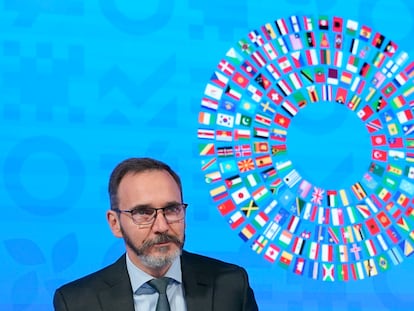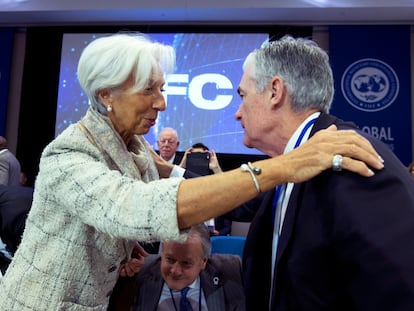US inflation falls to 3% in June, down from 9.1% a year ago
Prices are rising at their slowest pace since 2.6% in March 2021, but the Federal Reserve is still wary


U.S. inflation spiked by surprise in June 2022 to 9.1%, a four-decade high. Stock markets reacted downward, and the Federal Reserve stepped up interest rate hikes. After that peak, inflation has been falling every month, and consumer prices rose just 3% in June from 12 months earlier, according to data released Wednesday by the Bureau of Labor Statistics.
Core inflation, which excludes more volatile food and energy prices, is higher at 4.8%, but also down from the 5.3% rise in May.
The fall in year-on-year inflation was a foregone conclusion. In June 2022, prices rose by 1.3% month-on-month. The base effect, i.e., eliminating that month from the annual calculation, guaranteed a decline from May’s inflation figure of 4%.
Analysts’ forecasts pointed to headline inflation of 3.1% and core inflation of 5%. However, in one of those market paradoxes, investors expected inflation to come in below expectations.
Prices are rising at their slowest pace since 2.6% in March 2021. At that point, inflation started to spiral out of control due to bottlenecks in the supply chain, the liquidity injected during the pandemic, the increase in demand as Covid-19 restrictions were lifted and, later, the war in Ukraine and its impact on energy, food and raw materials.
Inflation is still clearly above the Fed’s 2% price stability target. Moreover, core inflation is well above it, leading officials at the central bank to be wary. After last June’s pause in the escalation of the price of money, the Fed is set to raise interest rates again on July 26, bringing them to their highest level since 2001.
Most analysts believe that a 0.25-point hike is a given, bringing rates into the 5.25%-5.50% range. Moreover, both the minutes of the last monetary policy committee meeting and the speeches of Fed officials have been along these lines. Three of them insisted on Monday that further rate hikes will be necessary this year to bring inflation back to the central bank’s target.
“We’ve made a lot of progress on monetary policy over the last year,” Federal Reserve Board of Governors Vice Chair for Supervision Michael Barr told a meeting of the Bipartisan Policy Center on Monday. “I would say we’re close, but we still have work to do.”
Barr was not alone. “We will likely need a couple more rate hikes later this year to get inflation back to a sustainable path of 2%,” San Francisco Fed President Mary Daly said at the Brookings Institution in Washington.
Cleveland Fed President Loretta Mester spoke along the same lines at a Monday event hosted by the University of California, San Diego: “My view is that the funds rate will have to rise somewhat higher from its current level and stay there for a while as we accumulate more information about the evolution of the economy.”
So far, the rate hikes have hardly cooled the labor market, nor have they triggered the recession that has been talked about for the past year. The Federal Reserve may not have won the battle against inflation, but for U.S. President Joe Biden, the price trend is a relief. Price hikes in groceries and gas made a dent in his popularity a year ago.
Now that inflation is easing, Biden is trying to sell somewhat skeptical citizens on the achievements of his economic policy, particularly record job creation and industrial and infrastructure investments.
Sign up for our weekly newsletter to get more English-language news coverage from EL PAÍS USA Edition
Tu suscripción se está usando en otro dispositivo
¿Quieres añadir otro usuario a tu suscripción?
Si continúas leyendo en este dispositivo, no se podrá leer en el otro.
FlechaTu suscripción se está usando en otro dispositivo y solo puedes acceder a EL PAÍS desde un dispositivo a la vez.
Si quieres compartir tu cuenta, cambia tu suscripción a la modalidad Premium, así podrás añadir otro usuario. Cada uno accederá con su propia cuenta de email, lo que os permitirá personalizar vuestra experiencia en EL PAÍS.
¿Tienes una suscripción de empresa? Accede aquí para contratar más cuentas.
En el caso de no saber quién está usando tu cuenta, te recomendamos cambiar tu contraseña aquí.
Si decides continuar compartiendo tu cuenta, este mensaje se mostrará en tu dispositivo y en el de la otra persona que está usando tu cuenta de forma indefinida, afectando a tu experiencia de lectura. Puedes consultar aquí los términos y condiciones de la suscripción digital.
More information
Archived In
Últimas noticias
Most viewed
- Sinaloa Cartel war is taking its toll on Los Chapitos
- Oona Chaplin: ‘I told James Cameron that I was living in a treehouse and starting a permaculture project with a friend’
- Reinhard Genzel, Nobel laureate in physics: ‘One-minute videos will never give you the truth’
- Why the price of coffee has skyrocketed: from Brazilian plantations to specialty coffee houses
- Silver prices are going crazy: This is what’s fueling the rally










































